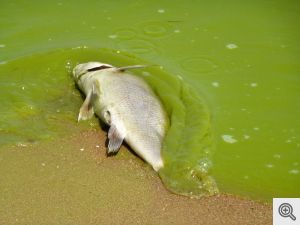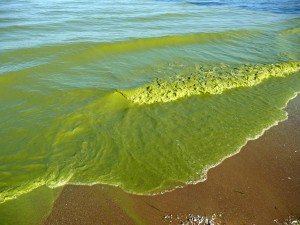IJC Report Released Today on Great Lakes Diversions, Consumptive Uses, and Climate Change Adopts Policy Prescription from FLOW, Great Lakes Water Law and Policy Center
TRAVERSE CITY, MI — The International Joint Commission issued a much anticipated report today on the success of the Great Lakes-St. Lawrence River Sustainable Water Resources Agreementand Compact ban on diversions and excessive consumptive water practices. While the IJC gave the Compact and efforts by states and provinces a positive grade, it also noted there is more work to do to assure these efforts are not undermined by lack of vigilance or unanticipated effects such as impacts from climate change and regional and local competition for water, energy and water in the coming decades.
“This is for the most part a good news story,” the IJC report concludes. The report notes that particular advancements are needed to address pressures for diversions and exports from droughts, worldwide water scarcity, and algal blooms from agriculture and sewage treatment plants, exacerbated by climate change. The report recommends immediate support for more data and better assessment of cumulative impacts from smaller incremental diversions, consumptive uses, or other human-induced changes such as global warming. It also emphasizes that decision-making standard for exceptions like the proposed Waukesha diversion must be strictly applied to avoid undermining the Compact.
Michigan water and environmental lawyer Jim Olson, President of FLOW (For Love of Water), a Traverse City-based Great Lakes water policy center, who submitted formal comments to the IJC on its initial draft of today’s report, said, “The IJC report and the in-depth consultants’ report not only document the success of the Agreement and Compact among the provinces and states to ban diversions and control consumptive uses to protect and conserve the waters and ecosystem in the Basin, it also spotlights the importance for governments to consider implementing a new game-changing, public trust principle as a ‘backdrop’ to safeguard the Great Lakes and citizens. It will prevent the Agreement and Compact from being undermined by possible political, economic, or uncertain or unexpected natural forces.”
At the outset of its report, the IJC observed that public comments from organizations and others “broadened considerations and strengthened the report,” including FLOW’s proposal to add “a new recommendation that states and provinces consider developing, harmonizing, and implementing a binational public trust framework as a backstop to the Agreement and Compact.”
“The recommendation of the public trust doctrine is leadership at its best,” Olson said. “This ancient principle holds that the waters of the Great Lakes are owned by the states and provinces in trust for the benefit of all citizens. Governments have a solemn duty as trustees to sustain these waters unimpaired as much as possible from one generation to the next. Understanding and applying public trust principles as a beacon to do the right thing will not only strengthen the diversion ban and the regulation of water use under the Compact,” Olson said, “it also will empower and guide governments, communities – including our tribes and indigenous peoples, businesses, and citizens – to find solutions to the massive threats that we face in the 21st century. What better way to harmonize our differences and focus our science and energies than bringing us back to the basic reality that we all live in a common home. It’s a traditional body of law that sets constructive guideposts, which, if we follow, will keep our countries, states, provinces, and people on course in protecting these highly valued public waters.”
The IJC report finds that “the Agreement and Compact will not necessarily be sufficient to protect the long-term ecological integrity and the many public and private uses of the Great Lakes. Binational adoption of public trust principles could provide an effective backstop,” and “it will fill the gaps and deal with as-yet-undefined stresses likely to negatively impact the Great Lakes in the future.”
Background to the IJC’s 2016 Report on Diversions and Consumptive Uses
An attempt by a corporation to divert water out of Lake Huron and ship it in tankers to China in 1999 sounded the alarm for Canada, the United States, all eight Great Lakes states, and two Great Lakes provinces to adopt an international agreement among all of these jurisdictions, and a separate Great Lakes Compact among the states. Prior to entering into any agreements, the IJC issued a scientific and policy report in 2000 on a protocol for protecting the Great Lakes from diversions and consumptive uses of water within and outside of the Basin. Negotiations between the jurisdictions and stakeholders from industry, communities, nonprofit organizations, tribes and public participation led to a draft agreement in 2004.
In response to more than 10,000 comments and letters, the draft was renegotiated around a call for the prohibition of any diversions of water outside of the Great Lakes Basin, with a handful of narrow exceptions, including one-time transfers for humanitarian purposes or to meet the needs of communities that straddle the Basin’s divide (such as the currently contested diversion of Lake Michigan water from Milwaukee to cities and towns in Waukesha County). In 2005, the governors of the states signed a Compact, and the governors and premieres of Ontario and Quebec signed a parallel international Agreement. The Compact was signed into law in 2008.
The 2016 IJC Report and the Future of the Great Lakes
In 2014, as part of its continuing responsibility to protect the flows, levels, and integrity of the Great Lakes and ecosystem, the IJC began an in-depth study to review its findings and conclusions in its 2000 report to account for significant changes or events each decade. Expert consultants to the IJC, Ralph Pentland, a Canadian water policy expert, and Alex Mayer, a U.S. science and engineering professor at Michigan Technological University, released draft findings for public review and comment from spring to the end of June in 2015.
IJC’s consultants Pentland and Mayer wrote in their 83-page report, which forms the basis of the IJC 2016 report, that the public trust would help address future water issues and trends, including the “uncertainty of climate and lake levels” and “losses that could approach the magnitude of losses related to diversions and consumptive uses.” They also found that “increasing droughts, storm events and the ‘nexus’ of intense competition for water sources for food, energy and development could override commitment to protect the Lakes,” and cited the California drought as “a reminder of communities literally running out of water.” Their findings also noted the current and evolving state of science that may better measure effects from human and natural forces in the future, prompting the need for a harmonizing public trust framework. An “uptick” in NAFTA or other international trade law claims against water restrictions and outside political pressures could shackle the Agreement and Compact in the future.
FLOW submitted comments on the draft IJC report last summer. Since 2011, FLOW has concentrated its work on the public trust doctrine as a potential framework for protecting and managing the Great Lakes, when it submitted, along with the Council of Canadians, a request to the IJC to review the public trust doctrine as a principle for its decisions under its 1909 treaty. FLOW has continued to submit research comments and published papers demonstrating the practical application of public trust standards to water levels, algal blooms, adaptive management practices, the straddling diversion exception in Waukesha, Wisconsin, net pen aquaculture, oil and gas state land leases, and crude oil pipeline transport on the bottomlands of the Great Lakes.
FLOW’s June 2015 comments on the IJC draft report analyzed the potential importance of the public trust as a guiding background by applying to the issues facing the Great Lakes. There is a vast body of precedent that shows that governments have a perpetual and affirmative duty to take necessary actions to protect water, people, public health, and the integrity of watersheds and ecosystems.
FLOW board member Keith Schneider, the senior correspondent for Circle of Blue’s Water News, said, “Elevating the public trust doctrine to a modern governmental strategy to secure water resources is an idea of momentous import for our region and North America.”
“The Agreement and Compact recognize water is a ‘public treasure’ that is ‘held in trust’ to benefit our citizens and communities,” Olson added. “Why not use it given the threats we see from climate change, invasive species, water exports and diversions, and increased water scarcity and greater competition? Without developing a legal framework that transcends the multi jurisdictions in the Great Lakes, we’re seeing increasing public health and environmental crises like the Flint water crisis, poisoning residents with lead and other chemicals for 18 months, and algal blooms in Lake Erie shutting down Toledo’s municipal water supply. Why wouldn’t we want a time-tested body of public trust law that applies equally to all 40 million beneficiaries designed to safeguard the Great Lakes?”
For References, see:
IJC 2016 10-Year Review Report
FLOW’s Public Trust Report on the Great Lakes to IJC

 These impacts strike at the heart of the Great Lakes and the uses enjoyed and valued by the 40 million residents who live in the Basin. In 2013, Toledo had to spend $1 million to treat its drinking water from toxic globs of algae. Unchecked, this chronic, worsening problem will strike a blow to the economy and quality of life in the Great Lakes region.
These impacts strike at the heart of the Great Lakes and the uses enjoyed and valued by the 40 million residents who live in the Basin. In 2013, Toledo had to spend $1 million to treat its drinking water from toxic globs of algae. Unchecked, this chronic, worsening problem will strike a blow to the economy and quality of life in the Great Lakes region. Algal blooms and toxic algae “dead zones” can be prevented and Lake Erie restored by reducing phosphorous loading from farming, sewage overflows, and fugitive residential and commercial fertilizing. If we continue to engage in dialogue but chose not to implement measures or options that will reduce phosphorous and restore Lake Erie, more beaches will close, commercial fishing will dry up, and tourism, riparian property values, public use of the lakes for recreation and enjoyment will continue to sink. The public trust provides a fresh approach based on traditional, time-tested principles that will provide the framework from which the states, stakeholders, and all citizens, who are the legal beneficiaries of this trust, can work together with shared responsibility to save this magnificent shared commons.
Algal blooms and toxic algae “dead zones” can be prevented and Lake Erie restored by reducing phosphorous loading from farming, sewage overflows, and fugitive residential and commercial fertilizing. If we continue to engage in dialogue but chose not to implement measures or options that will reduce phosphorous and restore Lake Erie, more beaches will close, commercial fishing will dry up, and tourism, riparian property values, public use of the lakes for recreation and enjoyment will continue to sink. The public trust provides a fresh approach based on traditional, time-tested principles that will provide the framework from which the states, stakeholders, and all citizens, who are the legal beneficiaries of this trust, can work together with shared responsibility to save this magnificent shared commons.



